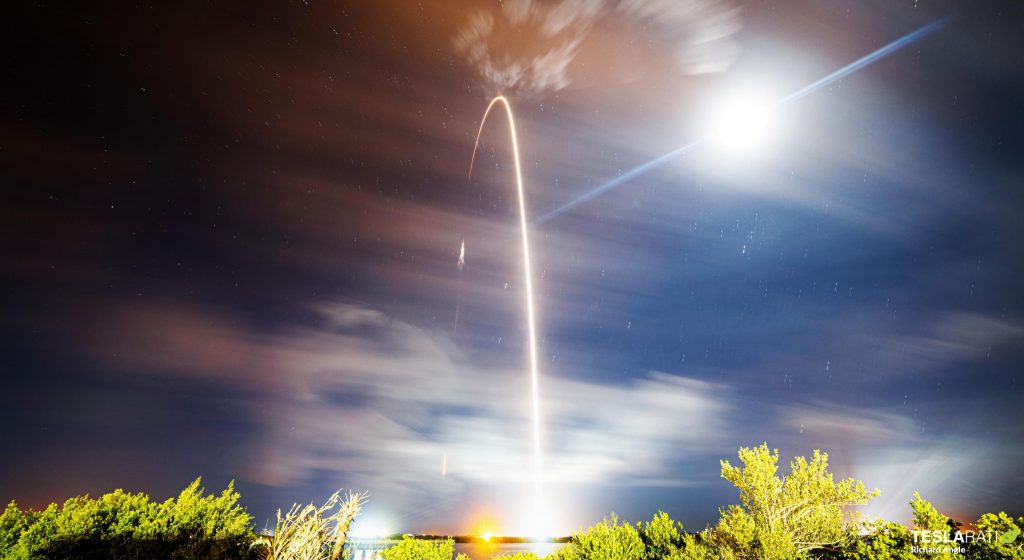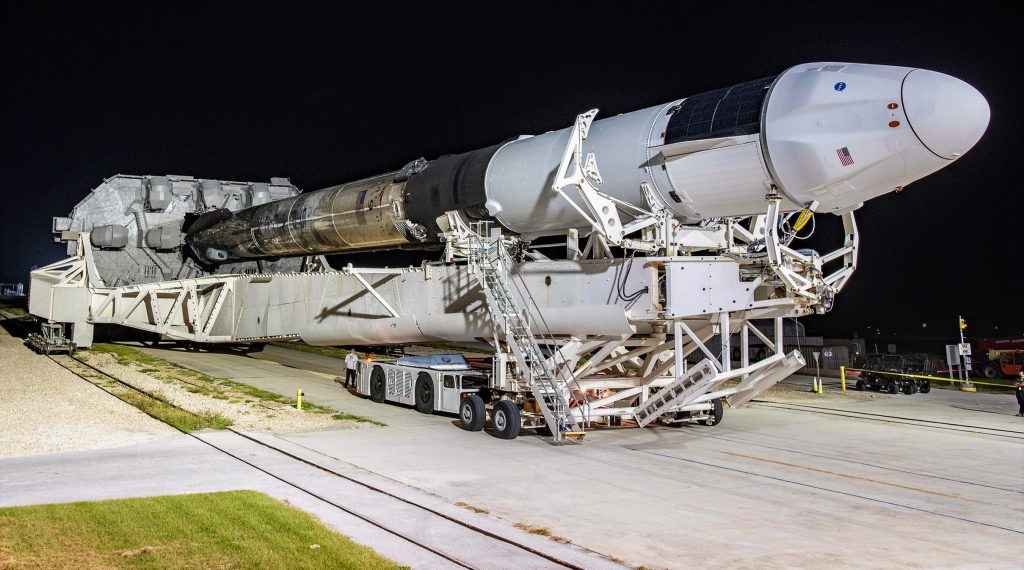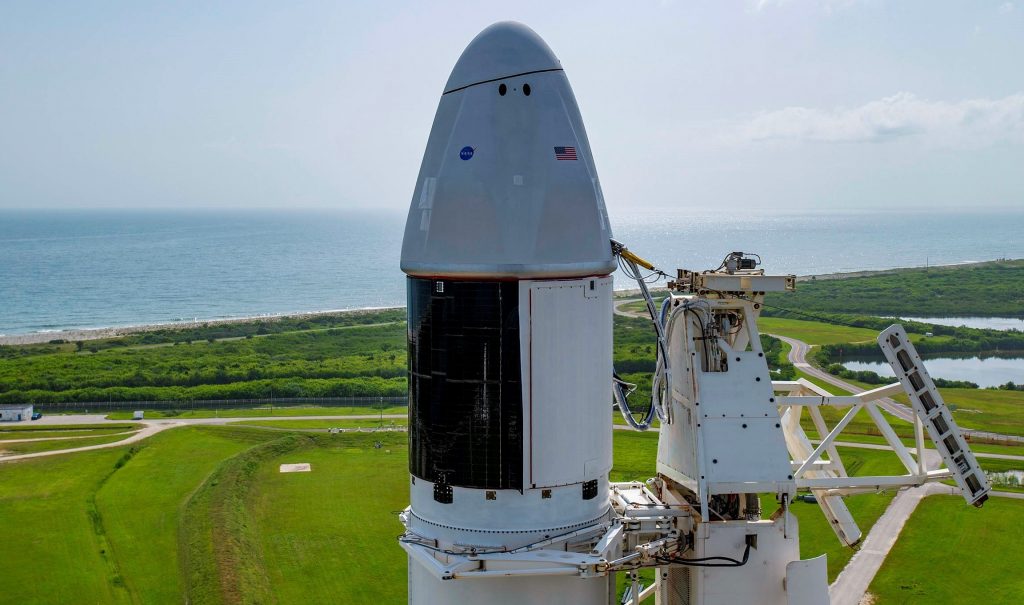

News
SpaceX sets Dragon reuse record, debuts drone ship on first launch in two months
Update #2: After a 24-hour weather delay, conditions were far more favorable on August 29th, allowing a SpaceX Falcon 9 rocket to lift off for the first time in almost two months and send a cargo-filled Dragon spacecraft on its way to the International Space Station (ISS).
Aside from marking the end of SpaceX’s longest launch hiatus in two years, CRS-23’s successful liftoff also means that the company has smashed the world record for fastest orbital space capsule reuse. As part of Cargo Dragon 2’s first reuse ever, SpaceX launched Dragon C208 just seven and a half months (227d) after its first orbital reentry and splashdown, handily beating the previous record of 328 days. Additionally, flying for the fourth time, Falcon 9 booster B1064 became the first rocket to land on brand new SpaceX drone ship A Shortfall of Gravitas (ASOG) after sending Dragon C208 on its way to the ISS.
Getting a nice view of CRS-23's trunk as it separates, confirming no trunk cargo on this flight. pic.twitter.com/ZeJjviKqFE— Jonathan McDowell (@planet4589) August 29, 2021

Update: Although the weather forecast has worsened, SpaceX remains on track to attempt its first launch in eight weeks – a mission that will also smash one of the company’s orbital spacecraft reusability records.
While mostly mundane, a system preceding Tropical Storm Ida is producing conditions less than optimal for rocket launches, raising the risk of in-flight lightning strikes and the chances of Falcon 9 and Dragon flying through clouds containing precipitation (rain/ice/etc). Ultimately, that means that there’s just a 40% chance (down from 50% in the last few days) that weather conditions will be favorable for SpaceX to launch CRS-23. Regardless, barring a surprise announcement in the next few hours, it appears that there’s enough of a chance that SpaceX and NASA will still make an attempt.
If all goes according to plan, a flight-proven Falcon 9 rocket will send an upgraded Cargo Dragon on the way to orbit for the second time in seven months – almost twice as fast a turnaround as SpaceX’s ~340-day record for orbital spacecraft reuse. Tune in below around 3:20am EDT (07:20 UTC) to catch the hopeful launch live.
For the first time in more than nine weeks, SpaceX has completed a routine Falcon 9 preflight test known as a static fire and verified that the rocket is ready to launch later this week.
Save for at least one booster qualification test completed at SpaceX’s McGregor, Texas development facilities, Falcon 9’s August 25th static fire is the first since June 22nd. The upgraded Cargo Dragon space station resupply mission the rocket will support will also be SpaceX’s first launch since June 30th – the company’s longest hiatus between launches since a three-month pause that began two years ago.
Now, just a few days before that drought is expected to end, a SpaceX executive has partially explained why the company hasn’t launched a single Falcon rocket in ~60 days after completing a record 20 orbital launches in the first half of 2021.
Speaking at the 2021 Space Symposium on August 24th, SpaceX President and COO Gwynne Shotwell revealed that the company had chosen to pause Starlink missions (representing the vast majority of its 2021 launches) and focus on preparing a new generation of satellites for flight. Believed to be called Starlink V1.5, those new satellites represent a relatively small design change save for one crucial addition: multiple lasers.
All the way back in mid-2018, SpaceX launched its very first pair of Starlink prototype satellites – spacecraft that largely functioned as expected and provided a wealth of data but were almost nothing like the Starlink V0.9 and V1.0 spacecraft SpaceX would eventually start launching in 2019. Nevertheless, they did carry sets of small lasers generally known as optical intersatellite links or OISLs for short. Not radically dissimilar to the hundreds of thousands of miles of fiber optic cables that make up the backbone of the internet, lasers operating in the vacuum of space can effectively mirror the extraordinary bandwidth and performance offered by fiber connections – but wirelessly.
Instead of carefully insulated cables filled with tiny threads of glass, which really just serve as a controlled environment for light-based communications, OISLs enable a similar feat by replacing cables with extraordinarily precise mechanisms capable of aiming lasers with sub-millimeter precision from dozens or hundreds of miles away. As a result, laser interlinks are fairly complex and expensive devices – not something currently economical to install on thousands of satellites mainly focused on affordability.
SpaceX, of course, has wanted to install unprecedentedly affordable laser interlinks on thousands of Starlink satellites for as long as the constellation has been publicly discussed. If realized, it would create an extraordinary orbital mesh network that would allow Starlink to self-route a large portion of user communications without the need for a colossal network of tens of thousands of ground stations covering every inch of Earth – land, sea, ice, and all. A Starlink constellation with near-universal laser interlinks could also potentially allow the constellation to not only match – but beat by a large margin – the latency of best-case terrestrial fiber-optic connections.
After effectively completing Starlink’s first ‘shell’ of satellites earlier this year, SpaceX shifted its focus to preparing for polar Starlink launches from both its west and east coast facilities. While the first shell lacked interlinks entirely, SpaceX appears to have decided that all polar Starlink satellites will be launched with its own custom-built space lasers, even if that means delaying Starlink launches until those lasers are ready for action. Due to the fact that the vast majority of SpaceX’s launches as of late have been its own Starlink missions, the company’s Falcon rockets simply haven’t had anything to launch.


That should change on August 28th, when a thrice-flown Falcon 9 booster launches a refurbished spacecraft on its second orbital space station resupply – a first for SpaceX’s upgraded Cargo Dragon 2 vehicle. A Shortfall of Gravitas (ASOG), SpaceX’s newest drone ship, will also be supporting its first Falcon landing ever as part of CRS-23, hopefully recovering Falcon 9 booster B1064 for a fifth launch later this year.
Tune in around 3:20am (07:20 UTC) on Saturday, August 28th to watch SpaceX’s first launch in two months live.
News
Tesla begins Robotaxi certification push in Arizona: report
Tesla seems serious about expanding its Robotaxi service to several states in the coming months.

Tesla has initiated discussions with Arizona transportation regulators to certify its driverless Robotaxi service in the state, as per a recent report from Bloomberg News. The move follows Tesla’s launch of its Robotaxi pilot program in Austin, Texas, as well as CEO Elon Musk’s recent comments about the service’s expansion in the Bay Area.
The Arizona Department of Transportation confirmed to Bloomberg that Tesla has reached out to begin the certification process for autonomous ride-sharing operations in the state. While details remain limited, the outreach suggests that Tesla is serious about expanding its driverless Robotaxi service to several territories in the coming months.
The Arizona development comes as Tesla prepares to expand its service area in Austin this weekend, as per CEO Elon Musk in a post on X. Musk also stated that Tesla is targeting the San Francisco Bay Area as its next major market, with a potential launch “in a month or two,” pending regulatory approvals.
Tesla first launched its autonomous ride-hailing program on June 22 in Austin with a small fleet of Model Y vehicles, accompanied by a Tesla employee in the passenger seat to monitor safety. While still classified as a test, Musk has said the program will expand to about 1,000 vehicles in the coming months. Tesla will later upgrade its Robotaxi fleet with the Cyercab, a two-seater that is designed without a steering wheel.
Sightings of Cybercab castings around the Giga Texas complex suggests that Tesla may be ramping the initial trial production of the self-driving two-seater. Tesla, for its part, has noted in the past that volume production of the Cybercab is expected to start sometime next year.
In California, Tesla has already applied for a transportation charter-party carrier permit from the state’s Public Utilities Commission. The company is reportedly taking a phased approach to operating in California, with the Robotaxi service starting with pre-arranged rides for employees in vehicles with safety drivers.
News
Tesla sets November 6 date for 2025 Annual Shareholder Meeting
The automaker announced the date on Thursday in a Form 8-K.

Tesla has scheduled its 2025 annual shareholder meeting for November 6, addressing investor concerns that the company was nearing a legal deadline to hold the event.
The automaker announced the date on Thursday in a Form 8-K submitted to the United States Securities and Exchange Commission (SEC). The company also listed a new proposal submission deadline of July 31 for items to be included in the proxy statement.
Tesla’s announcement followed calls from a group of 27 shareholders, including the leaders of large public pension funds, which urged Tesla’s board to formally set the meeting date, as noted in a report from The Wall Street Journal.
The group noted that under Texas law, where Tesla is now incorporated, companies must hold annual meetings within 13 months of the last one if requested by shareholders. Tesla’s previous annual shareholder meeting was held on June 13, 2024, which placed the July 13 deadline in focus.
Tesla originally stated in its 2024 annual report that it would file its proxy statement by the end of April. However, an amended filing on April 30 indicated that the Board of Directors had not yet finalized a meeting date, at least at the time.
The April filing also confirmed that Tesla’s board had formed a special committee to evaluate certain matters related to CEO Elon Musk’s compensation plan. Musk’s CEO performance award remains at the center of a lengthy legal dispute in Delaware, Tesla’s former state of incorporation.
Due to the aftermath of Musk’s legal dispute about his compensation plan in Delaware, he has not been paid for his work at Tesla for several years. Musk, for his part, has noted that he is more concerned about his voting stake in Tesla than his actual salary.
At last year’s annual meeting, TSLA shareholders voted to reapprove Elon Musk’s compensation plan and ratified Tesla’s decision to relocate its legal domicile from Delaware to Texas.
Elon Musk
Grok coming to Tesla vehicles next week “at the latest:” Elon Musk
Grok’s rollout to Tesla vehicles is expected to begin next week at the latest.

Elon Musk announced on Thursday that Grok, the large language model developed by his startup xAI, will soon be available in Tesla vehicles. Grok’s rollout to Tesla vehicles is expected to begin next week at the latest, further deepening the ties between the two Elon Musk-led companies.
Tesla–xAI synergy
Musk confirmed the news on X shortly after livestreaming the release of Grok 4, xAI’s latest large language model. “Grok is coming to Tesla vehicles very soon. Next week at the latest,” Musk wrote in a post on social media platform X.
During the livestream, Musk and several members of the xAI team highlighted several upgrades to Grok 4’s voice capabilities and performance metrics, positioning the LLM as competitive with top-tier models from OpenAI and Google.
The in-vehicle integration of Grok marks a new chapter in Tesla’s AI development. While Tesla has long relied on in-house systems for autonomous driving and energy optimization, Grok’s integration would introduce conversational AI directly into its vehicles’ user experience. This integration could potentially improve customer interaction inside Tesla vehicles.
xAI and Tesla’s collaborative footprint
Grok’s upcoming rollout to Tesla vehicles adds to a growing business relationship between Tesla and xAI. Earlier this year, Tesla disclosed that it generated $198.3 million in revenue from commercial, consulting, and support agreements with xAI, as noted in a report from Bloomberg News. A large portion of that amount, however, came from the sale of Megapack energy storage systems to the artificial intelligence startup.
In July 2023, Musk polled X users about whether Tesla should invest $5 billion in xAI. While no formal investment has been made so far, 68% of poll participants voted yes, and Musk has since stated that the idea would be discussed with Tesla’s board.
-

 Elon Musk1 week ago
Elon Musk1 week agoTesla investors will be shocked by Jim Cramer’s latest assessment
-

 Elon Musk3 days ago
Elon Musk3 days agoElon Musk confirms Grok 4 launch on July 9 with livestream event
-

 Elon Musk15 hours ago
Elon Musk15 hours agoxAI launches Grok 4 with new $300/month SuperGrok Heavy subscription
-

 News7 days ago
News7 days agoTesla Model 3 ranks as the safest new car in Europe for 2025, per Euro NCAP tests
-

 Elon Musk2 weeks ago
Elon Musk2 weeks agoA Tesla just delivered itself to a customer autonomously, Elon Musk confirms
-

 Elon Musk1 week ago
Elon Musk1 week agoxAI’s Memphis data center receives air permit despite community criticism
-

 Elon Musk2 weeks ago
Elon Musk2 weeks agoTesla’s Omead Afshar, known as Elon Musk’s right-hand man, leaves company: reports
-

 News2 weeks ago
News2 weeks agoXiaomi CEO congratulates Tesla on first FSD delivery: “We have to continue learning!”

















